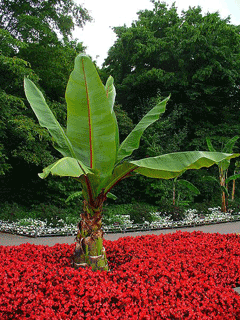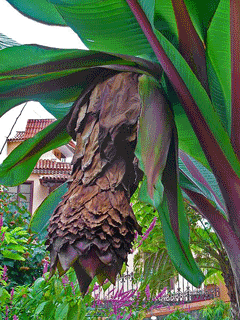 |
|
http://commons.wikimedia.org/wiki/User:Llez |
 |
| http://commons.wikimedia.org/wiki/User:Llez |
Translate this page:
Summary
Physical Characteristics

 Ensete ventricosum is an evergreen Perennial growing to 6 m (19ft) by 3 m (9ft).
Ensete ventricosum is an evergreen Perennial growing to 6 m (19ft) by 3 m (9ft).
See above for USDA hardiness. It is hardy to UK zone 10 and is frost tender. It is in leaf all year. The species is hermaphrodite (has both male and female organs).
Suitable for: light (sandy), medium (loamy) and heavy (clay) soils. Suitable pH: mildly acid, neutral and basic (mildly alkaline) soils. It cannot grow in the shade. It prefers moist soil.
UK Hardiness Map
US Hardiness Map
Synonyms
Musa ensete. M. ventricosum.
Plant Habitats
Woodland Garden Sunny Edge; South Wall. By. West Wall. By.
Edible Uses
Edible Parts: Root Seed Stem
Edible Uses:
The chopped and grated pulp of the corms and leaf sheaths is fermented and used as a flour in making kocho bread[134, 177, 183]. 100% kocho flour or a mixture of kocho and other cereal flours may be used[183]. It is said to taste like a good quality bread[2]. The endosperm of the seed is consumed as a food[183]. The base of the flower stalk is edible cooked[2, 177].
References More on Edible Uses
Medicinal Uses
Plants For A Future can not take any responsibility for any adverse effects from the use of plants. Always seek advice from a professional before using a plant medicinally.
None known
References More on Medicinal Uses
The Bookshop: Edible Plant Books
Our Latest books on Perennial Plants For Food Forests and Permaculture Gardens in paperback or digital formats.

Edible Tropical Plants
Food Forest Plants for Hotter Conditions: 250+ Plants For Tropical Food Forests & Permaculture Gardens.
More

Edible Temperate Plants
Plants for Your Food Forest: 500 Plants for Temperate Food Forests & Permaculture Gardens.
More

More Books
PFAF have eight books available in paperback and digital formats. Browse the shop for more information.
Shop Now
Other Uses
References More on Other Uses
Cultivation details
Industrial Crop: Fiber Management: Managed Multistem Regional Crop Staple Crop: Basic Starch
Requires a very sheltered sunny position in a fertile moisture-retentive soil[200]. This species is not very hardy in Britain but it succeeds outdoors on the Scilly Islands[134] and is sometimes used in sub-tropical bedding[1]. Plants can survive light frosts but they require ample shelter from the wind[166]. It should be possible to grow plants in tubs, keeping them outdoors in the summer and bringing them into a greenhouse or conservatory in the winter[K]. The leaves can be up to 6 metres long[188].
Carbon Farming
-
Industrial Crop: Fiber
Clothing, rugs, sheets, blankets etc. Currently, almost none of our fiber are produced from perennial crops but could be!
-
Management: Managed Multistem
Regularly removing some multiple stems. A non-A non-destructive management systems maintaining the soil organic carbon.
-
Regional Crop
These crops have been domesticated and cultivated regionally but have not been adopted elsewhere and are typically not traded globally, Examples in this broad category include perennial cottons and many nuts and staple fruits.
-
Staple Crop: Basic Starch
The Carbon Farming Solution. Eric Toensmeier.
References Carbon Farming Information and Carbon Sequestration Information
Temperature Converter
Type a value in the Celsius field to convert the value to Fahrenheit:
Fahrenheit:
The PFAF Bookshop
Plants For A Future have a number of books available in paperback and digital form. Book titles include Edible Plants, Edible Perennials, Edible Trees,Edible Shrubs, Woodland Gardening, and Temperate Food Forest Plants. Our new book is Food Forest Plants For Hotter Conditions (Tropical and Sub-Tropical).
Shop Now
Plant Propagation
Sow the large seed in individual pots in a heated greenhouse at any time of the year. Pre-soak the seed for 24 hours in warm water beforehand[200]. Germination should take place within 3 months. Grow on the plants for at least a couple of winters in the greenhouse before attempting to grow them outdoors. Division of suckers in spring. Try to get as much of the sucker's roots out as possible without disturbing the main plant too much. Pot the suckers up and grow them on in light shade in the greenhouse until they are established.
Other Names
If available other names are mentioned here
Native Range
AFRICA: Ethiopia, Kenya, Tanzania, Uganda, Rwanda, Angola, Mozambique, Malawi, Zambia, Zimbabwe, South Africa (Transvaal (north))
Weed Potential
Right plant wrong place. We are currently updating this section.
Please note that a plant may be invasive in one area but may not in your area so it's worth checking.
Conservation Status
IUCN Red List of Threatened Plants Status :

Growth: S = slow M = medium F = fast. Soil: L = light (sandy) M = medium H = heavy (clay). pH: A = acid N = neutral B = basic (alkaline). Shade: F = full shade S = semi-shade N = no shade. Moisture: D = dry M = Moist We = wet Wa = water.
Now available:
Food Forest Plants for Mediterranean Conditions
350+ Perennial Plants For Mediterranean and Drier Food Forests and Permaculture Gardens.
[Paperback and eBook]
This is the third in Plants For A Future's series of plant guides for food forests tailored to
specific climate zones. Following volumes on temperate and tropical ecosystems, this book focuses
on species suited to Mediterranean conditions—regions with hot, dry summers and cool, wet winters,
often facing the added challenge of climate change.
Read More
Expert comment
Author
(Welw.)Cheesman.
Botanical References
200
Links / References
For a list of references used on this page please go here
Readers comment